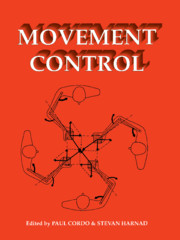Book contents
- Frontmatter
- Contents
- Preface
- 1 Does the nervous system use equilibrium-point control to guide single and multiple joint movements?
- 2 Does the nervous system depend on kinesthetic information to control natural limb movements?
- 3 Can sense be made of spinal interneuron circuits?
- 4 Implications of neural networks for how we think about brain function
- 5 Do cortical and basal ganglionic motor areas use “motor programs” to control movement?
- 6 Functional heterogeneity with structural homogeneity: How does the cerebellum operate?
- 7 Are movement parameters recognizably coded in the activity of single neurons?
- 8 The representation of egocentric space in the posterior parietal cortex
- Open Peer Commentary and Authors' Responses
- References
- Index
7 - Are movement parameters recognizably coded in the activity of single neurons?
Published online by Cambridge University Press: 11 December 2009
- Frontmatter
- Contents
- Preface
- 1 Does the nervous system use equilibrium-point control to guide single and multiple joint movements?
- 2 Does the nervous system depend on kinesthetic information to control natural limb movements?
- 3 Can sense be made of spinal interneuron circuits?
- 4 Implications of neural networks for how we think about brain function
- 5 Do cortical and basal ganglionic motor areas use “motor programs” to control movement?
- 6 Functional heterogeneity with structural homogeneity: How does the cerebellum operate?
- 7 Are movement parameters recognizably coded in the activity of single neurons?
- 8 The representation of egocentric space in the posterior parietal cortex
- Open Peer Commentary and Authors' Responses
- References
- Index
Summary
Abstract: To investigate neural mechanisms of movement, physiologists have analyzed the activity of task-related neurons in behaving animals. The relative onset latencies of neural activity have been scrutinized for evidence of a functional hierarchy of sequentially recruited centers, but experiments reveal that activity changes occur largely in parallel. Neurons whose activity covaries with movement parameters have been sought for evidence of explicit coding of parameters such as active force, limb displacement, and behavioral set. Neurons with recognizable relations to the task are typically selected from a larger population, ignoring those cells with complex relations to the task and unmodulated cells. Selective interpretations are also used to support the notion that different motor regions perform different motor functions; again, current evidence suggests that units with similar properties are distributed over widely different regions.
These coding issues are reexamined for premotoneuronal (PreM) cells, whose correlational links with motoneurons are revealed by spike-triggered averages. PreM cells are recruited over long times relative to their target muscles; they show diverse response patterns relative to the muscle force they produce; functionally disparate PreM cells such as afferent fibers and descending corticomotoneuronal and rubromotoneuronal cells can exhibit similar patterns. Neural mechanisms have been further elucidated by neural network simulations of sensorimotor behavior; the pre-output hidden units typically show diverse response patterns in relation to their target units.
- Type
- Chapter
- Information
- Movement Control , pp. 77 - 88Publisher: Cambridge University PressPrint publication year: 1994
- 23
- Cited by



